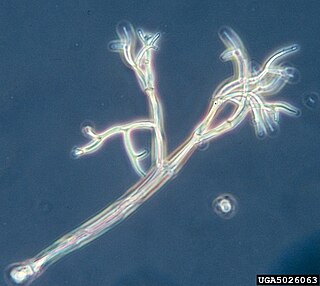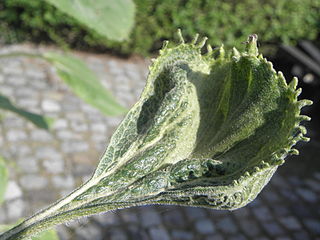
Qo inhibitors (QoI), or quinone outside inhibitors, are a group of fungicides used in agriculture. Some of these fungicides are among the most popular in the world. QoI are chemical compounds which act at the quinol outer binding site of the cytochrome bc1 complex.
Fungicides are biocidal chemical compounds or biological organisms used to kill parasitic fungi or their spores. A fungistatic inhibits their growth. Fungi can cause serious damage in agriculture, resulting in critical losses of yield, quality, and profit. Fungicides are used both in agriculture and to fight fungal infections in animals. Chemicals used to control oomycetes, which are not fungi, are also referred to as fungicides, as oomycetes use the same mechanisms as fungi to infect plants. Fungicides can either be contact, translaminar or systemic. Contact fungicides are not taken up into the plant tissue and protect only the plant where the spray is deposited. Translaminar fungicides redistribute the fungicide from the upper, sprayed leaf surface to the lower, unsprayed surface. Systemic fungicides are taken up and redistributed through the xylem vessels. Few fungicides move to all parts of a plant. Some are locally systemic, and some move upwardly.

Powdery mildew is a fungal disease that affects a wide range of plants. Powdery mildew diseases are caused by many different species of ascomycete fungi in the order Erysiphales. Powdery mildew is one of the easier plant diseases to identify, as its symptoms are quite distinctive. Infected plants display white powdery spots on the leaves and stems. The lower leaves are the most affected, but the mildew can appear on any above-ground part of the plant. As the disease progresses, the spots get larger and denser as large numbers of asexual spores are formed, and the mildew may spread up and down the length of the plant.

Downy mildew refers to any of several types of oomycete microbes that are obligate parasites of plants. Downy mildews exclusively belong to the Peronosporaceae family. In commercial agriculture, they are a particular problem for growers of crucifers, grapes and vegetables that grow on vines. The prime example is Peronospora farinosa featured in NCBI-Taxonomy and HYP3. This pathogen does not produce survival structures in the northern states of the United States, and overwinters as live mildew colonies in Gulf Coast states. It progresses northward with cucurbit production each spring. Yield loss associated with downy mildew is most likely related to soft rots that occur after plant canopies collapse and sunburn occurs on fruit. Cucurbit downy mildew only affects leaves of cucurbit plants.
A Biopesticide is a biological substance or organism that damages, kills, or repels organisms seens as pests. Biological pest management intervention involves predatory, parasitic, or chemical relationships.

Hyaloperonospora parasitica is an oomycete from the family Peronosporaceae. It has been considered for a long time to cause downy mildew of a variety of species within the Brassicaceae, on which the disease can cause economically important damage by killing seedlings or affecting the quality of produce intended for freezing. Hyaloperonospora parasitica causes downy mildew on a wide range of many different plants. It belongs to the Kingdom Chromista, the phylum Oomycota, and the family Peronosporaceae. The former name for H. parasitica was Peronospora parasitica until it was reclassified and put in the genus Hyaloperonospora. It is an especially vicious disease on crops of the family Brassicaceae. It is most famous for being a model pathogen of Arabidopsis thaliana which is a model organism used for experimental purposes. Accordingly, the former Hyaloperonospora parasitica has been split into a large number of species. For instance, the taxonomically correct name of the parasite of the well-known model organism Arabidopsis thaliana is Hyaloperonospora arabidopsidis, not H. parasitica, whereas the pathogen of Brassica has to be called Hyaloperonospora brassicae.
Pythium ultimum is a plant pathogen. It causes the damping off and root rot diseases of hundreds of diverse plant hosts including corn, soybean, potato, wheat, fir, and many ornamental species. P. ultimum belongs to the peronosporalean lineage of oomycetes, along with other important plant pathogens such as Phytophthora spp. and many genera of downy mildews. P. ultimum is a frequent inhabitant of fields, freshwater ponds, and decomposing vegetation in most areas of the world. Contributing to the widespread distribution and persistence of P. ultimum is its ability to grow saprotrophically in soil and plant residue. This trait is also exhibited by most Pythium spp. but not by the related Phytophthora spp., which can only colonize living plant hosts.

Peronospora sparsa is an oomycete plant pathogen that causes downy mildew in berry producing plants; especially in the genus's Rubus and Rosa. Downy mildew plant pathogens are often host specific and cause problems in cloudberries, blackberries, boysenberries, strawberries, and arctic bramble. Since they are host specific, Peronospora sparsa will not cause downy mildew in grapes because a different plant pathogen causes downy mildew in grapes; Plasmopara viticola. Although it depends on the cultivar, symptoms do not normally start until later stages of disease and can look different on different plants. The most common symptoms include red lesions in the veins of leaves, with dry and deformed berries.
Peronospora trifoliorum, commonly known as downy mildew of alfalfa, is an oomycete plant pathogen infecting alfalfa.
Sclerophthora macrospora is a protist plant pathogen of the class Oomycota. It causes downy mildew on a vast number of cereal crops including oats, rice, maize, and wheat as well as varieties of turf grass. The common names of the diseases associated with Sclerophthora macrospora include “crazy top disease” on maize and yellow tuft disease on turf grass. The disease is present all over the world, but it is especially persistent in Europe.

Peronospora farinosa is a species name that has been widely applied to downy mildew on leaves of wild and cultivated Amaranthaceae: Amaranthus, Atriplex, Bassia, Beta, Chenopodium, Halimione, Salsola, Spinacia, etc. However, the species name has been taxonomically rejected as the original description contained reference to multiple species and could not unequivocally be attributed to a species of Peronospora. In the past, some of the species on important crop plants have been given names as formae speciales, notably f.sp. betae on sugar beet and f.sp. spinaciae on spinach. However, phylogentic reconstructions have revealed that these "forms" of Peronospora on different genera and their subdivisions, are distinct species, most of which already have previously published scientific names. Such host specialization possibly also exists with respect to the various wild amaranthaceous species given as hosts of P. farinosa.

Peronospora manshurica is a plant pathogen. It is a widespread disease on the leaves of soybeans and other crop plants. The fungi is commonly referred to as downy mildew, "leafspot", or "leaf-spot".

Plasmopara halstedii is a plant pathogen infecting sunflowers. The species is one of many pathogens commonly referred to as downy mildew. P. halstedii originated in North America.

Plasmopara viticola, the causal agent of grapevine downy mildew, is a heterothallic oomycete that overwinters as oospores in leaf litter and soil. In the spring, oospores germinate to produce macrosporangia, which under wet condition release zoospores. Zoospores are splashed by rain into the canopy, where they swim to and infect through stomata. After 7–10 days, yellow lesions appear on foliage. During favorable weather, the lesions sporulate and new secondary infections occur.

Azoxystrobin is the ISO common name for an organic compound that is used as a fungicide. It is a broad spectrum systemic active ingredient widely used in agriculture to protect crops from fungal diseases. It was first marketed in 1996 using the brand name Amistar and by 1999 it had been registered in 48 countries on more than 50 crops. In the year 2000 it was announced that it had been granted UK Millennium product status.

Pseudoperonospora cubensis is a species of water mould known for causing downy mildew on cucurbits such as cantaloupe, cucumber, pumpkin, squash and watermelon. This water mould is an important pathogen of all these crops, especially in areas with high humidity and rainfall, such as the eastern United States. In most years the disease is an annual, late-season problem on squash and pumpkin in the eastern and central United States, however, since 2004 it has become one of the most important diseases in cucumber production. Considered a highly destructive foliar disease of cucurbits, successful breeding in the mid-twentieth century provided adequate control of downy mildew in cucumber without the use of fungicides. The resurgence in virulence has caused growers great concern and substantial economic losses, while downy mildew in other cucurbit crops continues to be a yearly hindrance.

Peronospora destructor is a plant pathogen. It causes downy mildew on leaves of cultivated and wild Allium. Allium cepa is most often affected, while Allium schoenoprasum (chives) and Allium porrum (leek) are only occasionally affected.
Commonly known as Philippine downy mildew, this disease is caused by the species Peronosclerospora philippinensis of the fungal-like protist class Oomycetes, which also has members such as water molds and Phytophthora infestans, which caused the potato blight that led to the Great Irish famine.

Fluxapyroxad is a broad-spectrum pyrazole-carboxamide fungicide used on a large variety of commercial crops. It stunts fungus growth by inhibiting the succinate dehydrogenase (SQR) enzyme. Application of fluxapyroxad helps prevent many wilts and other fungal infections from taking hold. As with other systemic pesticides that have a long chemical half-life, there are concerns about keeping fluxapyroxad out of the groundwater, especially when combined with pyraclostrobin. There is also concern that some fungi may develop resistance to fluxapyroxad.
Tree injection—also known as trunk injection or stem injection,—is a method of targeting a precise application of pesticides, plant resistance activators, or fertilizers into the xylem vascular tissue of a tree with the purpose of protecting the tree from pests, or to inject nutrients to correct for nutrient deficiencies. This method largely relies on harnessing the tree's vascular system to translocate and distribute the active compounds into the wood, canopy and roots where protection or nutrition is needed.












